
by threshold | Apr 4, 2024 | Creative, Design, Digital Marketing, General, Marketing, Tech/Web
PeakMade Real Estate came to us needing a platform that allowed for a more streamlined approach to websites across their portfolio and understood that the user journey is different across their various markets.
So we did what we do best, implementing website templates optimized for Peak’s audiences that have significantly reduced website development time and include a custom Entrata integration that converts better than any leading property management software on the market.
when we say best, we mean it.
We wanted to not only simplify website development but also provide PeakMade’s portfolio with a marketing tool that amplified lead generation. Each template design was to be innovative, with thoughtful movement of content to engage the viewer while not overwhelming them.
Our adaptable designs show an immediate improvement in conversion rates in the PeakMade portfolio, with lower costs to acquire leads when comparing the performance of their pay-per-click campaigns year-over-year from pre-templated Threshold websites to post.
Claremont Collegiate Apartments in Claremont, CA. saw:
- A 213% increase in conversion rate
- A 65% decrease in cost per conversion
University Gateway in Los Angeles, CA. saw:
- A 1,607% increase in conversion rate
- An 83% decrease in cost per conversion
Impressed? See more for yourself.
a custom integration? you got it.
Up until now, Entrata’s API allowed only floor plan pricing to be pulled into websites. Threshold built a custom integration for Entrata that retrieves several data points such as property floor plan details, availability, pricing, specials, and general property promotions, leveraging automation and increasing website accuracy and sustainability.
Our custom PeakMade templated designs and integration go far beyond the current property website capabilities, allowing property managers to:
- Set a custom pricing label option for floor plans with the ability to customize individual floor plan specials and floor plan name options
- Introduce a rent pricing override option for quick and easy discounted pricing updates when needed
- Create specials and offers that automatically remove themselves from the website when they expire
What does this mean for the property management teams?
- Information refreshes automatically
- No more spending precious hours updating leasing information or submitting requests through Threshold
- User-friendly back-end access to make certain edits on their own, without having to wait the standard 24-72 hour agency request turnaround time
- Focus on leasing and know that the property’s website is accurate and up-to-date
we love results.
How fast do you need a website? Because Threshold and PeakMade launched several of these custom website templates in only 26 business days. But the results don’t stop there.
When switching their property websites from Entrata templated designs to Threshold’s customized solution, PeakMade saw some dramatic improvements.
Taking a sample of 10 property websites from 2022-2023, the PeakMade team saw the following changes:
- Average time on a website increased by 33 seconds across all sites
- An engagement rate increase of 7.74%
- A goal conversion rate increase of 77.61%
before you go.
The 411? Using the Entrata designs and limited plugins was costing PeakMade properties conversions. Their new Threshold website templates look better than the previous property websites and provide a much-improved user experience that’s consistently resulting in better website engagement and higher lease numbers.
Let’s propel you forward. Your place for your every marketing need, with us you can go a la carte or take all the carts. Talk to a Marketing Specialist today.

by threshold | Nov 24, 2023 | Digital Marketing, General, Marketing
 Ava Page
Ava Page
Welcome to the ultimate Pay-Per-Click (PPC) guide to help you excel in your next marketing campaign (hopefully with us)! At Threshold Agency, we know that mastering PPC advertising
is like discovering a treasure trove for your marketing strategy.
Ready to dive into this guide? We’ll uncover the secrets and strategies that’ll turn your PPC game into a winning streak.
understanding the basics of ppc.
PPC is like planting seeds that instantly sprout into visibility and clicks. This advertising method charges you for every click your ad receives, making it a swift way to capture attention.
But the real magic lies in how you wield this power strategically.
keyword research and selection.
In the quest for the perfect keywords, think of yourself as a detective on a thrilling case. Use tools like Google Keyword Planner or SEMrush to uncover those hidden gems —
keywords with high searches and low competition. The longer the keyword, the more precise your aim.
crafting compelling ad copy.
Think of your ad copy as your knight in shining armor—bold, captivating, and irresistible! Weave in those chosen keywords naturally, flaunt your unique selling points,
and don’t forget the battle cry—a compelling call-to-action (CTA). Test different versions to see which holds the strongest impact.
optimizing landing pages.
So, you’ve lured them in with your ad—now what? Your landing page should be the treasure map that guides them to their bounty. Keep it relevant, user-friendly,
and armed with persuasive content that converts visitors into allies.
bid management and budget allocation.
Managing your bids
is like a strategic duel—constantly maneuvering to claim the winning spot. Keep a watchful eye on performance data, adjust bids, and allocate your budget
wisely to champion those high-performing keywords and audiences.
utilizing ad extensions.
Ad extensions are like adding secret compartments to your ad, offering more treasures to your audience. Site links, callouts, location extensions, and structured snippets —
these are the secret weapons that make your ad shine brighter.
tracking and analytics.
The tools you definitely need to make sure you have in your kit? Analytics, like Google Analytics and Google Ads. Dive deep into data to unravel trends, understand your
audience’s journey, and make informed decisions to steer your campaign toward success.
remarketing and retargeting.
It’s time to bring back those adventurers who have had a glimpse of the goods but haven’t committed. Tailor your ads to their interests or actions, encouraging them to
return and claim their reward – your brand!
continuous testing and optimization.
Think of PPC as a grand experiment—constantly mix, test, and refine. Tiny tweaks could unleash a tidal wave of success over time.
overwhelmed? don’t be.
This may seem like a lot of information, and even more setup and maintenance. After all, you’re busy running your brand! But, there’s no need to fret.
This is kind of our thing. Let us get your marketing where it needs to be. After all, we’re the ones who can market your everything.
to sum things up.
With these strategies under your belt, you’re on the brink of PPC mastery! At Threshold, we specialize in crafting tailored PPC strategies that take your brand on an
exhilarating journey to success.
Ready to embark on this adventure together? Reach out to us today.
before you go.
For more tips and information about marketing your everything, take a look at the rest of our blogs, right here on our website!
You can also subscribe to our email newsletter (it’s got some great stuff), and follow us on Instagram, Facebook, or LinkedIn!
about the author.
Ava is the SEO & Paid Media Specialist at Threshold.
In her role, she is responsible for the content creation and management of all Threshold and PromoShak social channels and strategies, blog content, SEO maintenance,
and aids in digital marketing activation. She’s kind of a jack-of-all-trades.
When she’s not busy creating content, you can usually find her picking out new plants, island-hopping, watching Duke basketball, or spending time with her fur babies.

by threshold | Oct 24, 2023 | Creative, Digital Marketing, General, Marketing
 Ava Page
Ava Page
We’re about to dive headfirst into the exciting world of copywriting – the secret sauce behind high-performing websites, ads, and social media content.
If you’re looking to boost your online presence and turn casual visitors into loyal customers, you’ve come to the right place.
the power behind words.
In the digital age, where attention spans are shorter than ever, your words matter more than you might think. Every word on your website, in your advertisements, and on your social media profiles should work like a magnet, pulling your audience in and compelling them to take action.
That’s the magic of high-converting copy.
why high-performing copy matters.
engagement.
Great copy sparks interest and keeps your audience engaged. It’s the bridge that connects your audience to your message.
conversions.
The ultimate goal of any online presence is to convert visitors into customers. High-performing copywriting can make that happen.
brand voice.
Your copy is your brand’s voice – it should be unique, relatable, and memorable.
Now, let’s roll up our sleeves and discover how you can create copy that works wonders for your business.
know your audience.
Before you put pen to paper (or fingers to keyboard), you must understand your audience inside and out.
Who are they? What problems do they face? How can your product or service solve those problems?
Tailor your message to speak directly to your audience’s pain points and desires.
embrace the AIDA formula.
AIDA stands for Attention, Interest, Desire, and Action. It’s a classic formula that works wonders for copywriting, like so:
attention.
The first step in creating high-performing copy is to capture your audience’s attention right from the start. Your headline or opening sentence is your first impression, and it needs to be compelling. Here’s how to do it:
create intrigue.
Start with something that piques curiosity or poses a thought-provoking question. For instance, “Are You Making These Common Mistakes in Your Marketing?”
interest.
Keep their interest alive by discussing their problems or needs.
power words.
Incorporate words that evoke emotion or excitement. Words like “ultimate,” “exclusive,” or “revolutionary” can add impact to your headline.
desire.
Show them how your product or service can fulfill their desires.
pain points.
Identify a problem your audience faces, and highlight it in your headline. People are drawn to solutions to their problems.
action.
Finally, ask for the action you want them to take, whether it’s signing up, buying, or sharing.
sense of urgency.
Encourage immediate action by introducing urgency, such as limited-time offers or deadlines.
keep things clear and concise.
In the online world, less is often more. Clear, concise copy is easy to read and understand. Avoid jargon and complex language. Instead, use simple words and short sentences that get your point across quickly.
tell your story.
Humans are wired to connect with stories. Weave narratives into your copy to make your brand more relatable and memorable. Share customer success stories or anecdotes that showcase your product or service’s value.
test and optimize.
Copywriting is an art, but it’s also a science. Don’t be afraid to A/B test different versions of your copy to see what resonates best with your audience. Use tools like Google Analytics to track the performance of your copy and make data-driven improvements.
keywords & SEO.
For web copy, don’t forget the importance of keywords. Research relevant keywords and incorporate them naturally into your content. This will not only make your content more search-engine friendly but also help you reach the right audience.
always proofread.
Nothing screams unprofessionalism like typos and grammatical errors. Always proofread and edit your copy to ensure it’s polished and error-free.
And, if you’re able, it’s always a plus to get a second set of eyes on your work to pick up on things you may have missed, or even to give you a suggestion on how to make something just a little better.
to sum it up.
High-conversion, high-performing copywriting isn’t just a skill – it’s an art that requires a deep understanding of your audience, a mastery of language, and a sprinkle of creativity.
By following these tips, you can transform your online presence, boost your conversions, and create a lasting impact in the digital world. Remember, it’s not just about words; it’s about the magic those words create.
So, go ahead, write with professionalism, craft with playfulness, and watch your conversions soar.
before you go.
For more tips and information about marketing your everything, take a look at the rest of our blogs, right here on our website!
You can also subscribe to our email newsletter (it’s got some great stuff), and follow us on Instagram, Facebook, or LinkedIn!
about the author.
Ava is the Content Marketing Specialist at Threshold.
In her role, she is responsible for the content creation and management of all Threshold and PromoShak social channels, blog content, and SEO maintenance, and aids in digital marketing strategies both internal and client-facing.
When she’s not busy creating content, you can usually find her picking out new plants, island-hopping, watching Duke basketball, or spending time with her fur babies.

by threshold | Sep 24, 2023 | Digital Marketing, General, Marketing, Tech/Web
 Ava Page
Ava Page
If you want to boost your website conversions, engage your audience, and drive more actions, don’t go anywhere – this one’s for you. We’re exploring the importance of CTAs (call-to-action), sharing best practices, and providing actionable tips on how to create catchy and effective content for your brand.
understanding the power of CTAs.
CTAs play a crucial role in guiding your audience towards the desired action. Whether it’s making a purchase, signing up for a newsletter, or visiting a landing page, a well-crafted CTA can make all the difference.
At Threshold, we believe that CTAs are the unsung heroes of digital marketing, capturing attention and persuading visitors to take the next step.
crafting captivating CTAs.
Creating an optimized CTA is both an art and a science. Here are some key tips to help you craft CTAs that grab attention and drive real results (they’re kind of our thing):
clear and actionable text.
Keep your CTA copy concise, compelling, and action-oriented. Use strong verbs that create a sense of urgency and motivate users to click. Examples include “Let’s Get Started,” “Start Exploring Now,” or “Claim Your Free Trial.” The more specific your content, the better!
visually appealing.
Design your CTAs in a way that makes them visually appealing and easy to spot. Consider using contrasting colors, eye-catching graphics, or animations to draw attention to your call-to-action buttons.
strategic placement.
Position your CTAs strategically on your website to ensure maximum visibility. High-converting locations include above the fold, at the end of blog posts, and on landing pages. Don’t be afraid to test different placements to find what works best for your audience.
a personalized experience.
Tailor your CTAs to match the interests and preferences of your target audience. Use dynamic content to show different CTAs based on user behavior, demographics, or past interactions. This personal touch can significantly increase engagement and conversions.
a/b testing.
To maximize the performance of your CTAs, never underestimate the power of continuous testing and optimization. A/B testing allows you to compare different variations of your CTAs to determine which ones yield the best results. Test different colors, copy, sizes, and placements to find the winning combination for your specific audience.
tracking & analytics.
To measure the effectiveness of your CTAs, it’s crucial to track their performance using analytics tools. Monitor click-through rates, conversion rates, and other relevant metrics to gauge the impact of your CTAs. This data provides insights into what works and what needs improvement, enabling you to refine your CTAs for better results over time.
leveraging CTA optimization services from Threshold.
At Threshold, we specialize in delivering measurable results. Our team of experts combines creative design, data-driven strategies, and industry best practices to create captivating and effective CTAs that drive conversions.
Partnering with us means benefiting from our cutting-edge technologies, and the assurance of high-quality marketing experience.
to sum it up.
Optimized CTAs are a game-changer in the world of digital marketing. Implementing the strategies and best practices discussed in this article will not only capture attention but also improve your website’s conversion rates. Unleash your creativity, and let your CTAs do the talking!
Oh, and don’t forget – at Threshold, we’re here to help you conquer the impossible (and save yourself the headache) and achieve outstanding results through our extensive expertise in CTA optimization.
Get in touch with us today and take your conversions to new heights!
before you go.
For more tips and information about marketing your everything, take a look at the rest of our blogs, right here on our website!
You can also subscribe to our email newsletter (it’s got some great stuff), and follow us on Instagram, Facebook, or LinkedIn!
about the author.
Ava is the Content Marketing Specialist at Threshold.
In her role, she is responsible for the content creation and management of all Threshold and PromoShak social channels, blog content, and SEO maintenance, and aids in digital marketing strategies both internal and client-facing.
When she’s not busy creating content, you can usually find her picking out new plants, island-hopping, watching Duke basketball, or spending time with her fur babies.

by threshold | Aug 24, 2023 | Creative, Digital Marketing, General, Marketing
 Ava Page
Ava Page
In this digital era, your brand’s reputation isn’t just built through word of mouth – it’s crafted through pixels and keystrokes. In a time where every click and comment can shape your brand’s destiny, it’s time to take control of your online narrative like a true champion.
As your ultimate partner for every marketing need, Threshold is here to unveil the secrets of online reputation management (ORM) that will not only protect your brand, but elevate it to new heights.
the power of first impressions.
Did you know that 91% of consumers read online reviews before making a purchase decision? Your potential customers are just a click away from forming their opinions about your brand. At Threshold, we understand the importance of making that first online impression count.
Our expert team carefully crafts your online narrative, ensuring your brand’s values and uniqueness shine through every review, comment, and mention.
turning negatives into positives.
Negative reviews can feel like a storm cloud over your brand’s sky, but fear not – they present an opportunity in disguise!
Studies show that 95% of customers return if a company handles their issues well. With our strategic approach, we transform disgruntled customers into loyal advocates, showcasing your brand’s dedication to customer satisfaction.
staying ahead in the digital landscape.
In a world where information travels faster than light, staying ahead of the game is crucial. Over 80% of consumers lose trust in a brand if they find incorrect information online.
Our proactive ORM strategies ensure that accurate information about your brand takes precedence, mitigating potential misinformation and enhancing your credibility.
the social proof phenomenon.
Social proof is the modern-day magic wand for brands. We’ve adopted the best practices in leveraging this phenomenon to curate a vibrant online community that resonates with your brand’s message.
From engaging social media content to fostering authentic customer interactions, we bring your brand to life in the digital sphere.
a holistic approach to orm.
Your online reputation isn’t just built on reviews and comments – it’s an intricate tapestry of various factors. At Threshold, we adopt a holistic approach to ORM, encompassing SEO optimization, content creation, social media management, and PR strategies.
Our multi-faceted techniques ensure that every aspect of your online presence aligns seamlessly, reinforcing your brand’s identity.
to conclude.
In the dynamic world of digital interactions, your brand’s reputation is the compass guiding customers to your doorstep – or inbox. With Threshold by your side, your online reputation isn’t just managed; it’s elevated to a whole new level.
before you go.
Remember, your reputation is your digital legacy – make it count with our THeam by your side. Your brand deserves nothing less than the best, and we’re here to deliver just that! Get in touch with one of our marketing experts today to embark on the journey of mastering your online reputation.
For more tips and information about marketing your everything, take a look at the rest of our blogs, right here on our website! You can also subscribe to our email newsletter (it’s got some great stuff), and follow us on Instagram, Facebook, or LinkedIn!
about the author.
Ava is the Content Marketing Specialist at Threshold.
In her role, she is responsible for the content creation and management of all Threshold and PromoShak social channels, blog content, and SEO maintenance, and aids in digital marketing strategies both internal and client-facing.
When she’s not busy creating content, you can usually find her picking out new plants, island-hopping, watching Duke basketball, or spending time with her fur babies.



 Ava Page
Ava Page
 Ava Page
Ava Page
 Ava Page
Ava Page
